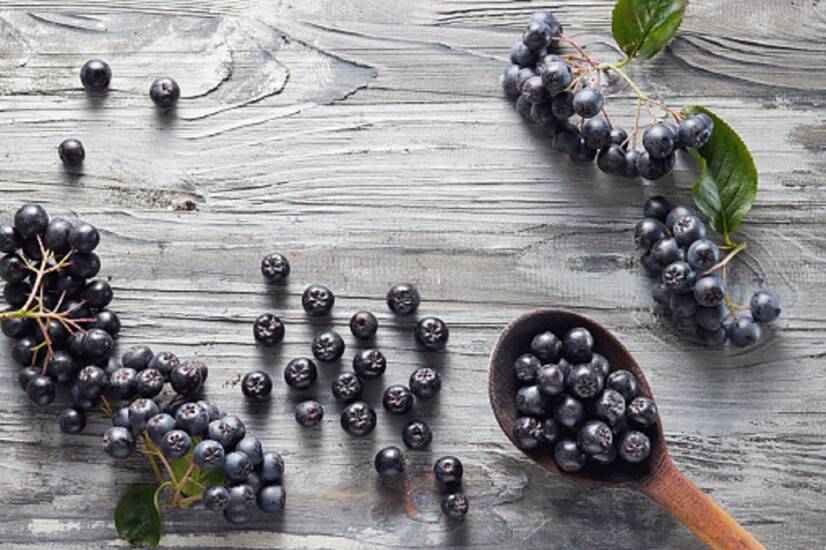- aronia-sk.sk - web portal focused on general information about aronia.
- missouribotanicalgarden.org - a foreign portal focused on health benefits.
- medicalnewstoday.com - growing, uses of chokecherries
Aronia: What are its health effects? (cultivation, use)

Aronia, also popularly called black cranberry and Latin Aronia melanocarpa, is a tree or shrub in the rose family (Rosaceae).
Characteristics
How to grow aronia and what are its health benefits? What are its uses and what are its beneficial effects on the body? The answers to these and other questions can be found in the article.
It is typically rather small and rarely taller than 1 m, rarely 3 m.
It spreads by root suckers.
The leaves are lanceolate, 2.5-7 x 2.5-3.5 cm in size, glabrous on the underside and hairy to glandular on the upper side.
Flowers are white to pinkish, sepals glabrous, triangular, petals oval to ovate.
During the growing season, aronia shrubs are very attractive, tolerate pruning and are also suitable as hedges.
Flowering begins in early spring (March) and blooms from April to May.
Throughout the year, the aronia is able to impress us with its beautiful leaves, which are dark green in colour.
In autumn, the leaves turn orange to deep red.
It can be classified as a low-maintenance plant in terms of soil and care. It tolerates frosty weather well and is also suitable for altitudes above 1 000 m above sea level.
The fruit ripens in September and should be eaten raw as it has a bitter taste.
Aronia products are very popular.
Cold-pressed juices, wines and liqueurs are most commonly made from the fruit.
Jams and preserves are the most popular.
Origin of the aronia
Its original homeland is North America, but over time it has spread all over the world.
It has several species, but the most well-known and widespread is the Melanocarpa species.
It was already considered a medicinal plant by our ancestors and therefore could not be missing from any garden.
Its fruits and leaves were used to cure various ailments, such as:
- colds
- stomach ailments
- anaemia
- headaches
Thanks to modern science, we now know that its effects are much broader than we originally thought.
Aronia, or black cranberry, is native to North America.
It was cultivated by ancient Native American tribes. It was known for its healing powers.
However, it is also known as the Siberian blueberry because it is most commonly grown in the countries of the former Soviet Union.
Internal use
Chokeberries have a beneficial effect on blood circulation and cholesterol levels.
Because the berries contain natural sorbitol (a sweetener suitable for diabetics), they are particularly beneficial for diabetes.
For robust health and vitality, aronia berries are beneficial because they contain many health-promoting substances, such as:
- valuable vitamins
- bioflavonoids
- rutin
- iron
- iodine
- fluorine
- manganese
- and various other trace elements
Let us briefly list some of the health benefits of chokeberry:
- it has a beneficial effect on the blood vessels and heart
- regulates blood pressure
- relieves stomach discomfort (treatment of stomach ulcers)
- removes heavy metals from the body (chokeberry was used in the Chernobyl nuclear accident)
- reduces the risk of atherosclerosis
- relieves headaches
- is effective for migraines
- relieves anaemia
- provides protection for the intestines and digestive tract
- prevents diabetes
- improves eyesight (prevents cataracts and protects eyes from UV rays)
- helps improve memory
- increases skin elasticity (slows the aging process)
- helps with chronic diseases (cancer, Parkinson's disease, bronchitis)
- has preventive effects in diseases of the liver and other organs of the digestive system
- improves thyroid function
- regulates hormone secretion
Black chokeberry has a huge supply of minerals:
- iron
- calcium
- magnesium
- phosphorus
- potassium
- zinc
- sodium
- manganese
- iodine
- boron
It is a rich source of vitamins A, B, C, E, K, P.
Malvica has a high content of sorbitol and polyphenolic substances.
Polyphenolic compounds are responsible for its beneficial effects.
Blueberries and cranberries have a lower content of these compounds (polyphenolic acids, procyanidins, anthocyanins and flavonols) compared to aronia.
The content of these substances depends on many factors such as the place of growth, the time of harvest and the method of processing. Sorbitol is considered a natural sweetener that is particularly suitable for people suffering from diabetes.
Compared to regular sugar, sorbitol has half the sweetness and is converted to fructose in the body.
External use
This herb makes a beautiful hedge.
It starts to flower very quickly in spring and its leaves remain on the branches until November.
In autumn, the green leaves gradually change from bright yellow to scarlet red.
In late April and May, a properly trimmed hedge produces beautiful flowers.
In late summer, the hedge is adorned with berries that change from green to reddish-purple to dark blue to black.
It is also important for its high dye content, which is used mainly in the food and textile industry.
Harvesting and storage
Aronia seedlings are annual and reach a height of 40-60 cm.
The seedlings have a well-developed root system.
As they are suitable for hedge planting, 3 to 5 seedlings per linear metre are recommended.
Another type of seedling is the biennial seedling, which is 80-110 cm tall.
These seedlings have a strong trunk and their root system is larger, allowing them to take up nutrients more quickly.
After planting, around the first year, they grow faster.
They can be planted either as a hedge or as a solitary plant.
Growing this herb is easy, it can grow in any type of soil.
It does not mind sunlight or too much shade.
Its dark purple fruits, which are almost black, attract attention from July onwards.
The ripe fruits are eaten fresh.
The best time to harvest aronia is in September, when the fruit is at its tastiest.
They are also healthy pickled, but fresh berries in particular are healthier.
Their bitter taste can be softened by mashing the fruit, to which honey or cream can be added.
The recommended amount that can be consumed per day is 30 berries.
Retrieved from
Among the most important products from aronia are cold-pressed fruit juices.
The juices are gradually pasteurized at a temperature of 85-95℃ for 15 minutes.
The juice can be considered a good prevention against serious diseases of the liver and other organs of the digestive system.
Juice is generally taken as the most powerful natural antioxidant.
Other uses:
- Syrups
- jellies
- jams
- compotes
- addition to fruit yoghurts
- fruit juices mixed with apples, oranges or other fruits
- fruit is also used to make wine or brandy
- fruit can also be dried or stored as tea.
Nutritional values of black chokeberry:
| Energy value | 371 KJ |
| Protein | 0,71 g |
| Carbohydrates | 20 g |
| Fats | 0,63 g |
| Fibre | 2 g |
Interesting resources










